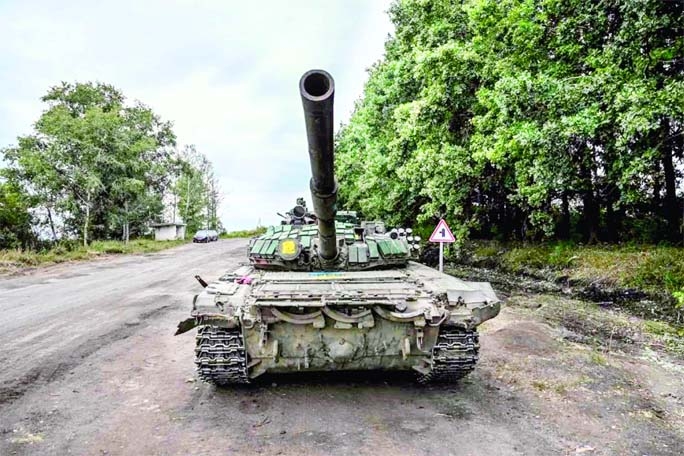
News Desk :
Ukraine’s military has captured over 200 Russian vehicles in a more than weeklong offensive that has seen the war-torn country reconquer most of Kharkiv Oblast, a Ukrainian military official told Foreign Policy. The harvest of Russian armor is something that Ukraine now plans to use against the flagging Russian military.
As Russian forces surrendered more than 2,300 square miles to advancing Ukrainian troops in a little over a week-more ground than Russia has taken in the last five months of fighting-some troops running for their lives left vast stashes of Soviet-era weaponry, which the defending Ukrainians can now operate, including at least 17 vehicles on Monday alone.
Open-source tracker Oryx found that the captured Russian equipment varied from BMP-2 amphibious infantry fighting vehicles to scores of tanks, including T-80 variant tanks that date back to the 1980s, which experts pegged at about half of the combat-ready inventory. With poorly trained Russian units, some cobbled together from Russia’s national guard and police forces, falling away from the front lines, Ukrainian forces stumbled upon an embarrassment of riches on the battlefield.
“They just left their tanks, artillery, special equipment, a lot of armor, and were just trying to save their lives,” a Ukrainian military official told Foreign Policy, speaking on condition of anonymity to provide an update on ongoing military operations. “They will be used against Russia.”
But even with formidable U.S. and European military aid that made the Kharkiv assault possible, including multiple rocket launch systems and artillery, Ukraine is doubling down on its calls for more weapons in an effort to liberate as much Russian-occupied territory as possible before winter sets in.
“The U.S. didn’t start their Lend-Lease program, but instead of the U.S., the Russian government started a Lend-Lease program for Ukrainian forces,” the official added, referring to the World War II-era program to provide U.S. allies with food, oil, and materiel that has been revived for Ukraine.
The losses of equipment, vehicles, and troops from the Ukrainian surge in the last week have also left some Russian units in tatters. Britain’s defense ministry reported on Tuesday that the 1st Guards Tank Army-one of Moscow’s most prestigious military units, tasked with guarding the Russian capital or leading counterattacks in
a possible war against the NATO alliance-was withdrawn from Kharkiv in a “severely degraded” state. “It will likely take years for Russia to rebuild this capability,” the ministry assessed.
For months, as the full-scale invasion has forced parts of Ukraine’s robust defense industry-one of the largest in the former Soviet Union and one of the biggest arms-producers, period-into semi-hibernation, the Ukrainian military has been able to capture, modify, and repurpose Russian equipment left behind or rendered ineffective on the battlefield, experts said.
“They’re doing a lot of mods, like interesting things with captured Russian equipment,” said Jeb Nadaner, a former U.S. deputy assistant secretary of defense for industrial policy during the Trump administration. “They’ve got a capability, particularly with captured equipment.” Russian strikes have targeted industrial facilities, such as Kharkiv’s tank repair plant and the Malyshev tank factory, forcing Ukraine to repurpose garages and junkyards to repair their vehicles or prepare captured Russian equipment to meet its maker.
But the capture of perhaps hundreds more modern and Soviet-era Russian vehicles comes as Ukrainian officials are pressing the Biden administration at high levels to send advanced Western main battle tanks to Ukraine, as the war-torn country has shown a higher degree of capability with tank and armored vehicle assaults against poorly defended Russian positions over the course of the lightning offensive. Speaking to reporters on Monday, a senior U.S. military official, speaking on condition of anonymity based on ground rules set by the U.S. Defense Department, said reports of Russian troops abandoning equipment “could be indicative of Russia’s disorganized command and control.”
The Ukrainian military official who spoke to Foreign Policy said modern NATO-grade battle tanks, such as the M1 Abrams or German Leopards, were high on the list of Kyiv’s requests to the United States and European countries at the Ramstein conference last week. The German Leopards appear more amenable to European armies versed on similar kit.
Ukraine’s seemingly insatiable appetite for more tanks is the sharp end of the military’s desire to reclaim as much territory as possible before winter, experts said, when Russian President Vladimir Putin is likely to use natural gas cuts and attacks on Ukrainian energy infrastructure to sap Western enthusiasm for the fight.
“That’s why we are saying it’s very important to get back as much of our land as possible before the winter comes,” said Alyona Getmanchuk, founder and director of New Europe Center, a Kyiv-based foreign-policy think tank, on Monday.
Although Ukrainian officials are optimistic about getting more tanks from the United States and Europe in the coming days, the West has been noncommittal at best. German defense minister Christine Lambrecht rejected a Ukrainian call for tanks on Monday. And while the United States acknowledged that Ukraine’s armor assaults had been effective in Kharkiv, it wasn’t clear that more aid was on the way.
“The Ukrainians are showing that they are quite effective in the counteroffensive in using armor,” a senior U.S. defense official told reporters on Monday, speaking on condition of anonymity based on ground rules set by the Pentagon. “So, clearly, that kind of capability is important.”
(Courtesy: Foreign Policy.)

